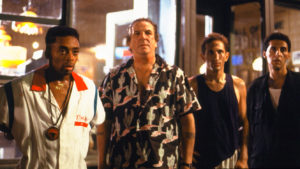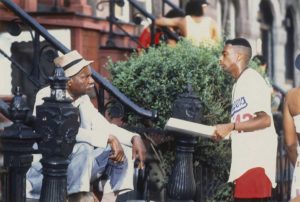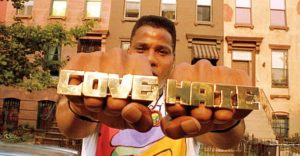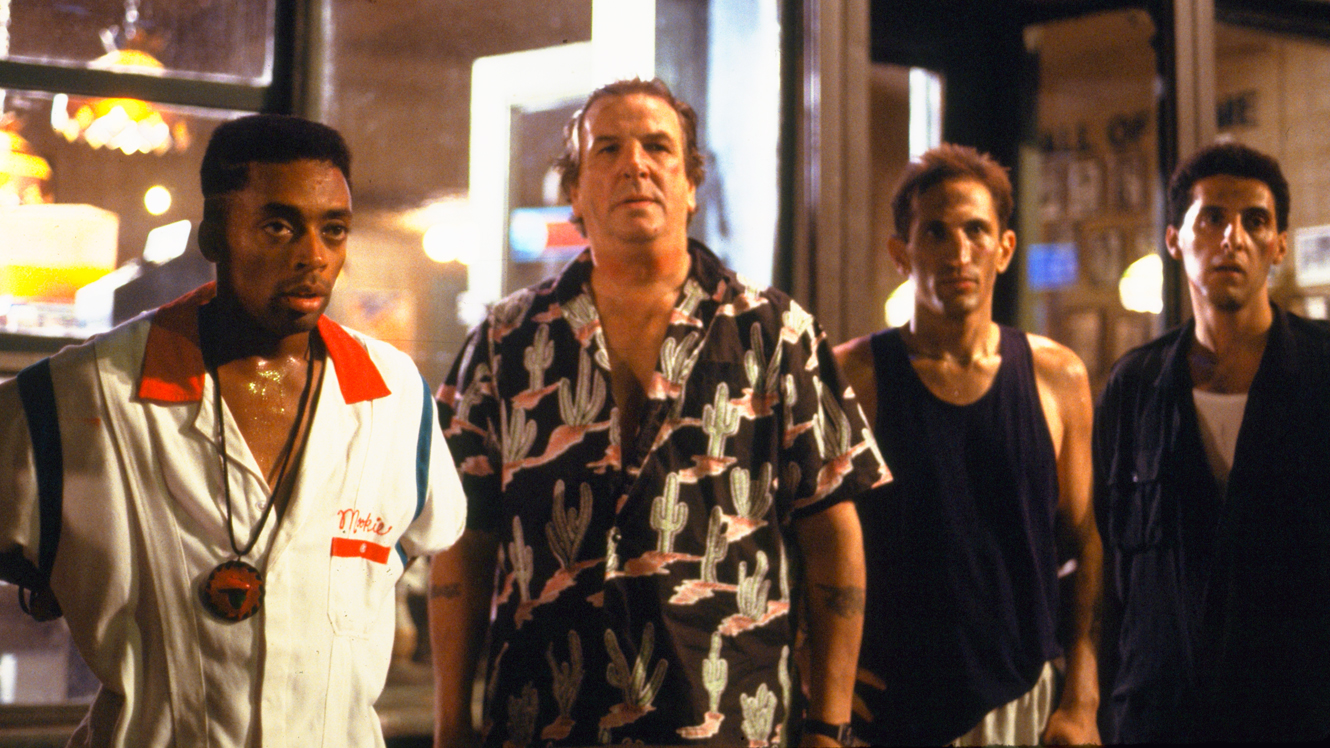Movie Info
Movie Info
- Director
- Spike Lee
- Run Time
- 2 hours
- Rating
- R
VP Content Ratings
- Violence
- 5/10
- Language
- 9/10
- Sex & Nudity
- 5/10
- Star Rating
Relevant Quotes
He has told you, O mortal, what is good; and what does the Lord require of you but to do justice, and to love kindness, and to walk humbly with your God?

July 21 will be the 30th Anniversary of the release of Spike Lee’s now classic film Do the Right Thing. It was such a prophetic (and controversial) film that it merits attention even today, not just for its historic significance—the 3rd in Lee’s oeuvre, it catapaulted him to international fame—but because it so clearly foretold the future of interracial relationships in America. Its climax focuses upon the death of a black youth at the hands of a zealous white cop, a tragedy that has been repeated over and over since then. My first review, written for the Catholic magazine Marriage and Family Living, has been lost, but my initial reaction of wonder and admiration that a filmmaker could be as powerful as a Hebrew prophet in exposing the dark side of our society still resonates within me.
Lee begins the soundtrack just ahead of the title. We hear the strains of James Weldon Johnson’s anthem “Lift Every Voice and Sing,” often referred to as “The Negro National Anthem.” But after just one verse it is replaced by the driving beat of Public Enemy’s “Fight the Power,” a call to resist the white racist system that dominates society. Throughout the rest of the extensive front credits we see a video of Rosie Perez dancing to the song in front of the facades of decrepit buildings on a street in the Bedford-Stuyvesant district of Brooklyn. As she gyrates through a series of dance moves, her costume changes back and forth from miniskirt and tights to that of a female boxer. Later Rosie will appear in the less sexy/seductive role of Tina, Mookie’s (Spike Lee) long suffering girlfriend.
The story, which will unfold over one eventful torrid summer day, begins at 8 A.M. with Samuel Jackson’s fast-talking radio jockey Mister Senor Love Daddy summoning his listeners to get out of bed. It will be the hottest day of the year, he announces, as he looks out onto the street. from his storefront studio, Station W(e)L(ove)R(adio), ”The color of the day is black to absorb some of those rays!”
Other characters are quickly introduced. Still prone in his bed is Ossie Davis, called Da Mayor. Even though he is addicted to Miller’s Highlight, Da Mayor presides over the street with a benevolence befitting a wealthy benefactor. It is he who will give the film its title, telling Mookie, “Do the right thing,” advice that Mookie shrugs off. Sitting on the side of his bed counting his savings Mookie, wears the jersey of his idol Chicago Bull’s player Michael Jordan. When he turns and plays with the lips of a sleeping woman, we might think she is his girlfriend. Instead, she turns out to be his sister Jade (Joie Lee, Spike’s real sister), who is allowing him to board with her temporarily—and who apparently has been responsible for his present job, one that we soon see he dos not take seriously.

Arriving in the neighborhood in a swank Cadillac is Sal Frangione, owner of Sal’s Famous Pizzeria. With him are his two sons Pino (John Turturro) and Vito (Richard Edson). When the neighborhood changed from Italian to black, they moved to Bensonhurst, but Sal feels a loyalty to his customers, saying how he has seen them grow up on his food. Vito has become friends with Mookie, who is the pizzeria’s delivery man, but Pino hates the neighborhood, its people, and Mookie in particular. He is trying to convince his father to sell the place. The brothers begin the day arguing who should carry out Sal’s order to sweep up the debris in front of the store. When Mookie arrives (late as usual), he also refuses to do sweep, replying that his job is to deliver pizzas, not to clean up. It will be Da Mayor, coming in to earn some beer money, who will carry out Sal’s order, much to the disgust of Pino.
Other characters include:
– Radio Raheem (Bill Nunn), a burly athletic looking black walking the street with his giant boom box blasting out, “You got to fight the power, fight the power, fight the powers that be.” (Spike Lee says in his commentary that the anthem is used 26 times!) Even fellow blacks tell him to turn down the sound, but the one objecting the most is Sal, ordering him to turn the sound off when Raheem comes in to buy a slice of pizza.

-Looking out her window is Mother Sister (Ruby Dee), one who knows everybody’s business and who keeps benevolent watch over the children playing in the streets. She is especially judgmental toward Da Mayor and his constant drinking, but will mellow when the old man later turns out to be a hero. -Smiley (Roger Guenveur Smith), a retarded man with a bad stutter, tries to sell copiess of the famous picture depicting the Rev. Dr. Martin Luther King Jr. and Malcolm X smiling together. That picture will be the last image that we see in the film.
-Buggin Out (Giancarlo Esposito), a young man full of anger, will become the catalyst for the riot at the film’s climax. He is upset that Sal’s “Wall of Fame” includes only famous Italian Americans. The latter refuses to add any black celebrities, telling him to get his own store. Buggin Out tries to get the neighborhood to boycott Sal, but everyone loves Sal’s pizza too much to pay him any attention.
-Sitting in front of a bright red brick wall beneath a shade umbrella are three men who act as a chorus by offering comments on everyone and everything, M L (Paul Benjamin), Coconut Sid (Frankie Faison) and Sweet Dick Willie (Robin Harris). They are especially upset by the Koreans who have opened up the grocery store across the street from Sal. However, while one spews out his hatred and envy of the prosperous Koreans, another points out his laziness that has made him a spectator and not a doer.
-The Korean Sonny (Stephen Park) and his wife work long hours at the neighborhood’s only grocery store. They are well aware of the hostility of most of their customers, despite the fact that they too have been considered as outsiders by whites. Only Sal gives them a friendly greeting at the beginning of the day hen he gets out of his car.
-Last of all is Tina (Rosie Perez), Mookie’s neglected Puerto Rican girlfriend and the mother of his infant son, Hector. She berates him for not coming by very often and for his lack of ambition and interest in their child, almost reaching a breaking point when he continues to offer excuses for not spending much time with them.

Lee injects lots of small incidents that bring alive for viewers the neighborhood. Children laughing and playing in the spray of illegally opened fire hydrants. Girls effortlessly executing the intricate steps of a jumping rope game. A younger woman sitting behind Mother Sister on the front steps as she brushes out the older woman’s hair. A group sits on another stoop opening cans of beer to beat the heat. Teenagers angering a white driver by spraying his trophy convertible with fire hydrant water. A white bicyclist accidentally besmirching the Air Jordans of Buggin Out and narrowly escaping a beating by the angry black’s friends. Two cops in a car drive by, exchanging hate stares with the three idlers. Da Mayor negotiates with a boy to go buy him a beer, and then is verbally assaulted by some teenagers who show him no respect.
The filmmaker also shows the ugly prejudice that infects everyone. Several denizens yell out a stream of racial epithets that incorporate virtually every insult they can think of—targeted are blacks, whites, Jews, Italians, and Koreans. Tempers, already shortened due to the extreme heat, explode at the end of the day when Buggin Out and Radio Raheen return to Sal’s and demand pizza slices at closing time. Raheen, refusing to turn down his boom box, pushes Sal to his breaking point. Yelling out a string of racial slurs, Sal picks up his baseball bat and bashes to pieces the offending boom box. The two blacks attack the Italian, and soon, with Sal’s two sons defending him amidst a pile of bodies, the parlor is a chaos of struggling men, with bystanders drawn by the noise. The brawl spills out onto the sidewalk, where more and more people rush up. Then the police arrive with their Billy clubs, arrest Buggin Out, and try to subdue Raheen. Attempting to bring the large black youth to the ground, one cop clings to him from behind, his Billy club choking off the boy’s air. A fellow cop cries out twice in protest, “Gary, that’s enough!” But by the time that the cop lets up, Raheen has stopped breathing.
The onlookers are so enraged that they start to move on the cops. Mookie goes across the street for a trash can and diverts their attention by throwing it through Sal’s window. (According to Lee, diversion is not his intention. Instead, it is seeing his friend die before his eyes that causes him to want to destroy his employer’s shop. Nonetheless, the mob does turn from Sal and the cops and direct their fury against the shop.) They rush into the pizzeria destroying everything they can grab. Finished with trashing Sal’s they are about to attack the Korean store as well, but its owner Sonny, with just his broom as a defense, pleads, “I no white! I black! You, me, same! We same!” This gets through, the mob sparing his shop. In the scene closely following this, be sure to catch what Smiley does when he enters the burnt out pizzeria and confront what remains of Sal’s ”Wall of Fame.”
The next day there is a touch of reconciliation that concludes the film, but certainly no warm fuzzy ending like another film that also came out in 1989, Driving Miss Daisy. (Strange to look back and see that at the Academy Awards Daisy was given four awards, but Lee’s none! But who would prefer to revisit that likeable but saccharine work now instead of Lee’s hard-edged work? Okay, I suppose there are still naïve white liberals who would rather be made to feel good about race relations than to confront them in the comfort-upsetting reality of Spike Lee’s film.)
It is fascinating how skillfully Spike Lee holds up opposites throughout the film.
-The film starts off with the stately “Negro National Anthem” and switches to Public Enemy’s protest song.
-There is the theme of responsibility and irresponsibility, both his sister and girlfriend accusing Mookie of the latter, as does Sister Sister regard Da Mayor. Indeed, it is the women who think ahead to the future, while the men seek their own immediate pleasures.
-There are the two brothers, Pino hating Mookie and other blacks, and Vito befriending Mookie.
-Radio Raheen wears steel knuckles, one reading “Hate,” and the other “Love.” In a symbolic sequence he shows Mookie how he believes that Love wins over Hate.
-Smiley’s photo of Martin Luther King, Jr. and Malcom X will conclude the film, right after two quotations from these leaders.
-King’s is about violence never being justified, and Malcolm X’s that violence is “intelligent” when used in self-defense.
Thus this film raises questions well worth exploring. I would love to see churches sponsor a program that leads off with this vintage film that foretold the future all too well and then follow up with Ava DuVernay’s When They See Us, which broadens the scope of Lee’s film—from the toxic affects of racism in one neighborhood to that of city-wide and eventually nation-wide. It is debatable who in the film does “the right thing,” but by bringing back this film, you will certainly be doing so.
Due to its strong street language leaders (and about 5 seconds of a female bare breast) will want to proceed with caution, preparing participants for what some will consider an assault on their ears. But the insights that a group could gain are worth the effort. In fact, who knows what might result from such a discussion—remember what happened in Chicago when a young community organizer named Barack Obama took Michelle Robinson on their first date to see the film and then discussed it at a Baskin-Robbins?
This review will be in the August issue of VP along with a set of questions for reflection and/or discussion. If you have found reviews on this site helpful, please consider purchasing a subscription or individual issue in The Store.


Ed,
We have a monthly social justice film program at Crescent Hill Baptist Church (Louisville KY), and a couple of years ago we showed Do The Right Thing. I was troubled at the response of our (small) group of white viewers, who were incensed that Mookie threw the garbage can and set off the riot. Their response was that Sal was a good guy, helping this community out and Mookie’s action hurt an already struggling
community. All of this is true, but Radio Raheem’s death had simply not registered in their consciousnesses. It demonstrated to me our white blindness in being unable to see people of color as of equal worth. (And I include myself in that judgment, since I had not connected Mookie’s action with his best friend’s death until I watched one of the Lee’s interviews in one of the extra features of my DVD copy.) You are right that this film is as relevant today as it was when first released.
Ed – When I first saw “Do the Right Thing,” I thought the title was meant to be ironic. In the film, *nobody* does the right thing, and everyone is in some way responsible for what happens. But I thought that was Spike Lee’s point — that when we define ourselves by our races, we set ourselves against each other, and it results in violence.
At the same time, Lee shows us both sides of the neighborhood, black and white, and gives us characters that we can emphasize with. That’s what makes the violence at the end all the more devastating. We know the people in this neighborhood should be friends; it’s their racial interpretations of each other that turn them against each other.
Thanks for your insights, Rob. Sorry to be so late in replying–just found your comment.
Bill Thomason’s comment above highlights an interesting aspect of “Do the Right Thing.” It is a film that is interpreted differently by viewers of different races. Spike Lee has said, “White people have asked me if Mookie does the right thing by throwing a garbage can through the window of Sal’s Pizzeria, after Radio Raheem is killed. But no person of color has ever asked me that question.”
At the same time, Lee understands that “Do the Right Thing” may inspire different interpretations. Lee has repeatedly stated that the reason that Mookie threw the garbage can through the window was in anger over Raheem’s death. But he acknowledges the alternative theory that Mookie did it to save Sal, Pino and Vito from the angry mob. Although that was never his intention, Lee likes the fact that the scene has sparked such different interpretations.
Good point, Richard. Thanks.